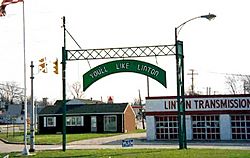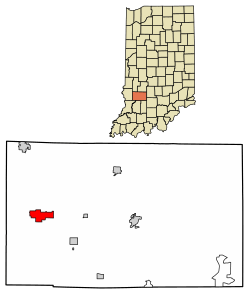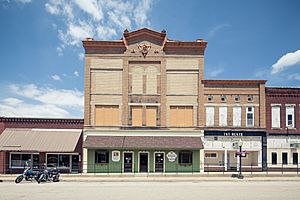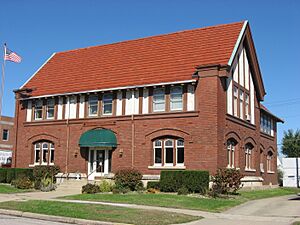Linton, Indiana facts for kids
Quick facts for kids
Linton, Indiana
|
|
|---|---|

"You'll Like Linton"
|
|

Location of Linton in Greene County, Indiana.
|
|
| Country | United States |
| State | Indiana |
| County | Greene |
| Township | Stockton |
| Area | |
| • Total | 3.20 sq mi (8.29 km2) |
| • Land | 3.20 sq mi (8.29 km2) |
| • Water | 0.00 sq mi (0.00 km2) |
| Elevation | 502 ft (153 m) |
| Population
(2020)
|
|
| • Total | 5,133 |
| • Density | 1,603.56/sq mi (619.17/km2) |
| Time zone | UTC-5 (EST) |
| • Summer (DST) | UTC-4 (EDT) |
| ZIP code |
47441
|
| Area code(s) | 812 |
| FIPS code | 18-44190 |
| GNIS feature ID | 2395726 |
Linton is a city in Greene County, Indiana, United States. It is located in Stockton Township. In 2020, about 5,133 people lived there. Linton is known for its history of coal mining. It is also part of the Bloomington, Indiana, metropolitan area.
Contents
History of Linton
Linton began to grow thanks to John W. Wines. He first sold goods in the area in 1831. He later opened a general store in Linton in 1837. He also built a small mill and a tannery. The city was officially named and started in June 1850. Hannah E. Osborn and Isaac V. Coddington planned its layout.
In the late 1800s, small underground coal mines opened near the city. This caused the population to grow quickly. By the early 1900s, Linton had more people than it does today. In the 1920s, there were many places to drink and many churches.
Labor and Industry in Linton
Linton has a strong history with labor unions. In 1903, union miners took action against non-union workers. This showed the strong union presence in the area.
By the 1920s, surface mines became more common. These mines left behind small hills and lakes. These lakes are now used for fishing. Signs of the old underground mines can still be seen today. These include old structures and sinkholes. Large companies like Peabody Coal Company took over mining by the 1940s. These mines were the main employers until the 1980s.
In 1919, telephone operators in Linton went on strike. They wanted better pay and shorter hours. They also wanted their union to be recognized. The company brought in new workers. This made many local union members upset. A general strike was then called for all union workers in town.
Tensions grew, and the mayor asked for the Indiana National Guard to come. The National Guard's presence made things even more tense. There was some violence, but only minor injuries happened. The strike ended with the company agreeing to raise wages and lower hours. However, they did not recognize the union.
In 1952, General Electric built a factory in Linton. It employed hundreds of people. But in the mid-1980s, GE stopped most of its small motor production in the U.S. The factory building was empty for many years. GE tore it down starting in 2014.
Historic Landmarks
On April 29, 1963, a strong tornado hit Hoosier, north of Linton. It was the strongest tornado ever in Greene County.
The Linton Commercial Historic District and the Linton Public Library are important places. They are listed on the National Register of Historic Places. This means they are recognized for their historical value.
Geography of Linton
Linton covers about 3.02 square miles (7.82 square kilometers). All of this area is land.
Population of Linton
| Historical population | |||
|---|---|---|---|
| Census | Pop. | %± | |
| 1890 | 958 | — | |
| 1900 | 3,071 | 220.6% | |
| 1910 | 5,906 | 92.3% | |
| 1920 | 5,856 | −0.8% | |
| 1930 | 5,085 | −13.2% | |
| 1940 | 6,263 | 23.2% | |
| 1950 | 5,973 | −4.6% | |
| 1960 | 5,736 | −4.0% | |
| 1970 | 5,450 | −5.0% | |
| 1980 | 6,315 | 15.9% | |
| 1990 | 5,814 | −7.9% | |
| 2000 | 5,774 | −0.7% | |
| 2010 | 5,413 | −6.3% | |
| 2020 | 5,133 | −5.2% | |
| U.S. Decennial Census | |||
2010 Census Information
In 2010, Linton had 5,413 people living there. There were 2,325 households. The city had about 1,792 people per square mile. Most of the people were White (97.7%). Other groups included African American, Native American, and Asian. About 1.2% of the population was Hispanic or Latino.
About 29.6% of households had children under 18. The average household had 2.30 people. The average family had 2.88 people. The median age in Linton was 39.8 years. About 23.4% of residents were under 18. About 19.2% were 65 or older.
Arts and Culture in Linton
Linton has several fun events and cultural spots.
Linton Music Festival
The Linton Music Festival was known as "Mayberry meets Woodstock." In 2010, over 12,000 people attended. This festival was free and offered entertainment for all ages. It featured music for different tastes. The festival aimed to promote music, local business, and tourism. It ran annually from 2005 to 2013. It was held on the Friday, Saturday, and Sunday before Labor Day.
Carnegie Heritage and Arts Center
The Carnegie Heritage and Arts Center of Greene County helps preserve history. It takes care of the historic 1908 Margaret Cooper Public Library building. This building is a Carnegie library. It also holds a collection of items from famous entertainers Phil Harris and Alice Faye.
Freedom Festival
Linton has celebrated Independence Day since 1905. The events include Indiana's largest Independence Day parade. Over 40,000 people come to see it. There is also a week-long traveling carnival. Local music and entertainment are featured. The celebration ends with fireworks on the Fourth of July.
Marsh Madness
This festival started in 2010. It celebrates the wildlife at the Goose Pond Fish and Wildlife Area. Goose Pond is a project south of the city. It has successfully brought back wetlands to their natural state. The goal is to encourage hunting, fishing, and nature trips.
Notable People from Linton
- Chuck Bennett, football player and coach.
- Gene Porter Bridwell, seventh Director of the NASA Marshall Space Flight Center.
- David Butler, first Governor of Nebraska.
- Izzy Friedman, musician, composer.
- Phil Harris, musician, actor, and comedian.
- Dorothy Mengering, mother of David Letterman.
- Elmer Oliphant, football player.
- Spencer Pope, football player.
See also
 In Spanish: Linton (Indiana) para niños
In Spanish: Linton (Indiana) para niños



